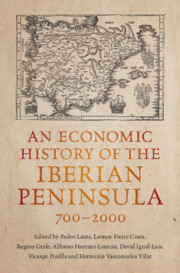Book contents
- An Economic History of the Iberian Peninsula, 700–2000
- An Economic History of the Iberian Peninsula, 700–2000
- Copyright page
- Contents
- Figures
- Tables
- Contributors
- Preface: By Way of Presentation
- Introduction
- Part I The Making of Iberia, 700–1500
- Section I The Early Middle Ages, 700–1200
- Section II The Medieval Economy, 1000–1500
- 2 Production, 1000–1500
- 3 Population, 1000–1500
- 4 The Polity, 1000–1500
- 5 Money, Credit and Banking, 1000–1500
- 6 Technology, 1000–1500
- 7 Living Standards, 1000–1500
- 8 International Trade and Commerce, 1000–1500
- 9 The Iberian Economy in Global Perspective, 700–1500
- Part II Globalization and Enlightenment, 1500–1800
- Part III Industrialization and Catching Up, 1800–2000
- References
- Index
3 - Population, 1000–1500
from Section II - The Medieval Economy, 1000–1500
Published online by Cambridge University Press: 22 February 2024
- An Economic History of the Iberian Peninsula, 700–2000
- An Economic History of the Iberian Peninsula, 700–2000
- Copyright page
- Contents
- Figures
- Tables
- Contributors
- Preface: By Way of Presentation
- Introduction
- Part I The Making of Iberia, 700–1500
- Section I The Early Middle Ages, 700–1200
- Section II The Medieval Economy, 1000–1500
- 2 Production, 1000–1500
- 3 Population, 1000–1500
- 4 The Polity, 1000–1500
- 5 Money, Credit and Banking, 1000–1500
- 6 Technology, 1000–1500
- 7 Living Standards, 1000–1500
- 8 International Trade and Commerce, 1000–1500
- 9 The Iberian Economy in Global Perspective, 700–1500
- Part II Globalization and Enlightenment, 1500–1800
- Part III Industrialization and Catching Up, 1800–2000
- References
- Index
Summary
The evolution of population and settlement in the Iberian Peninsula during the Middle Ages has similarities and differences with the rest of Western Europe. The differences arise from the process of territorial expansion and feudal colonization developed by the Christian kingdoms against Al-Andalus. That also determined diverse situations among the Christian kingdoms and regional contrasts within them. This chapter explores the evolution of population between approximately 1000 and 1500. The introduction offers a preliminary reflection on the sources and their possibilities and limits. In the second section, the patterns of population change and migration are discussed. Despite some methodological issues, some population figures and their evolution are offered for each area. This shows an evolution in which the late medieval crisis and, above all, the Black Death had a great impact, although uneven in the different kingdoms and territories. The study of rural and urban settlements is addressed in the third section, relating its characteristics and evolution to the social and economic structure in the different areas. Finally, the fourth section studies the population weight and the characteristics of the following urban socio-professional sectors: workers, artisans and merchants.
- Type
- Chapter
- Information
- An Economic History of the Iberian Peninsula, 700–2000 , pp. 76 - 101Publisher: Cambridge University PressPrint publication year: 2024



